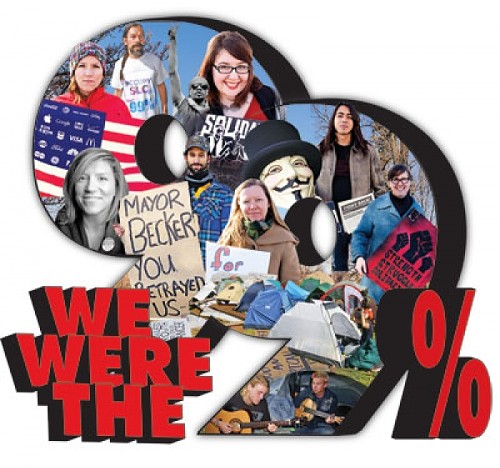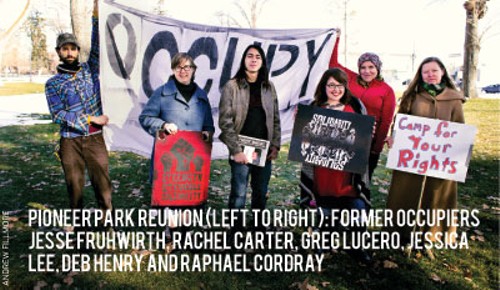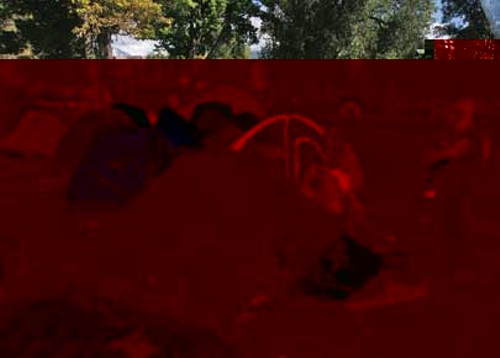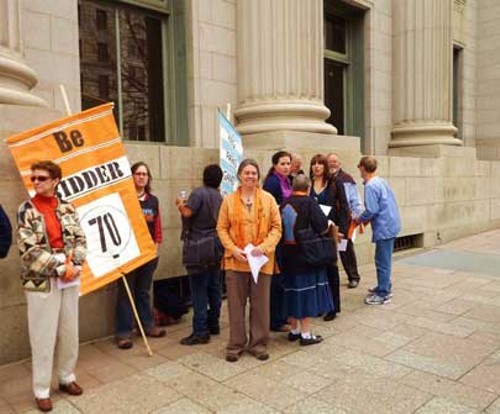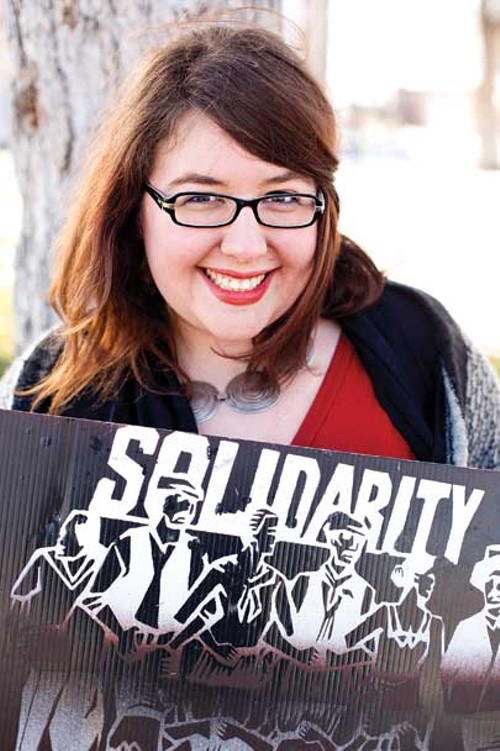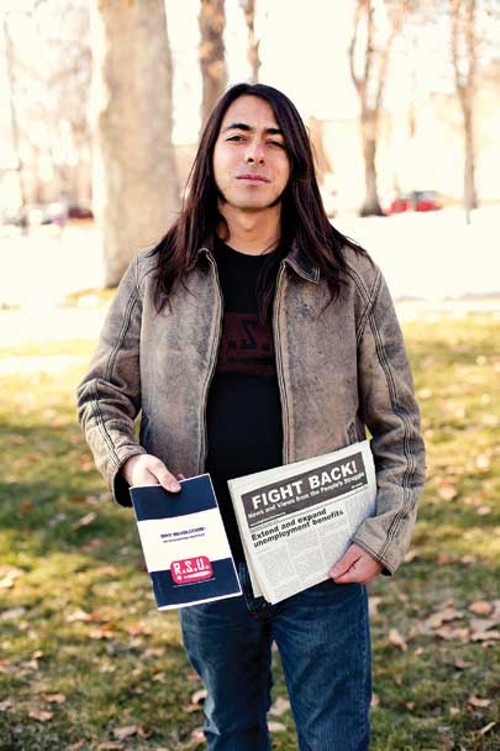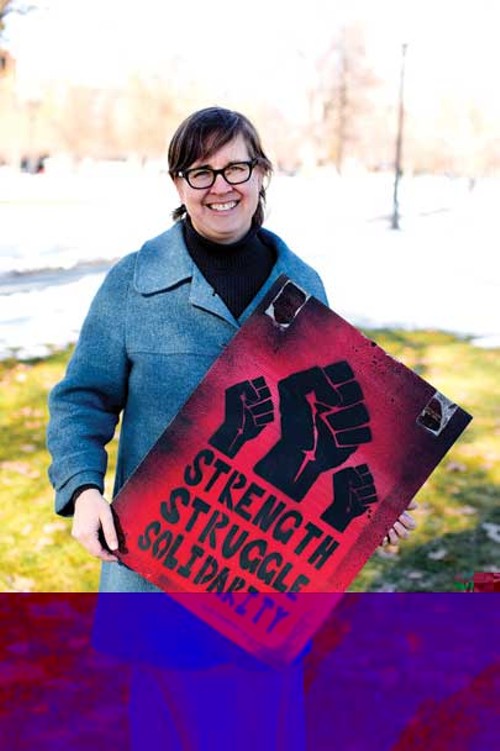It was a frosty, makes-your-ears-hurt, body-numbing kind of day. But if you’d been walking past West Valley City Hall on Jan. 22, 2013, you’d have seen about 30 demonstrators marching in the cold, holding signs that read “WE DEMAND JUSTICE” and “POLICE MURDER.”
The protesters wanted answers from West Valley Police about the Nov. 2, 2012, death of 21-year-old Danielle Willard. Willard was shot while in her car by two drug detectives. To date, it has yet to be determined if the shooting was justified.
On the sidewalk among the protesters, a miniature altar had been erected, draped in a black cloth. It held a single object, a digital picture frame, which cycled through a slideshow of images of Willard as a small child, as a teenager enjoying nature, as a young adult smiling with friends and family. Then, her story ended abruptly. She appeared to have been a gentle, normal girl—someone it’s hard to believe posed a threat to police.
A middle-age male protester arrived to join the group. He shouted, “Who’s in charge here?”
“We’re all in charge,” replied Jesse Fruhwirth, a 32-year-old journalist-turned-activist. Bundled up against the cold, he greeted friends, introduced himself to strangers and passed out slips of paper with Salt Lake County District Attorney Sim Gill’s phone number. He explained who Danielle “Deedee” Willard was to those who didn’t know her.
Formerly a silent observer at events like these, Fruhwirth was now the one responding to questions posed by reporters of Channel 2 News, Fox 13 and KSL.
So why did Fruhwirth quit his 9-to-5 with City Weekly, after having also worked for the Tooele Transcript-Bulletin and Ogden’s Standard-Examiner, earning top awards for his reporting from the local Society of Professional Journalists? “I don’t understand why people don’t more live in accordance with what they believe as fully and completely as they can,” he says.
Part of what shaped Fruhwirth’s identity as an activist was his involvement in a movement that’s lately been forgotten and dismissed. Remember Occupy Salt Lake?
“It was huge moment in my life,” he says. “There was a lot of ‘no going back’ for a lot of people.”
The turning point for Fruhwirth took place on a chilly night in November 2011.
According to news accounts, more than 70 police officers from the Salt Lake City Police Department and Salt Lake County’s Unified Police Department assembled Nov. 12, 2011, to roust the 70-some members of Occupy Salt Lake from their tent city, established 38 days prior. Salt Lake City Mayor Ralph Becker and Salt Lake City Police Chief Chris Burbank ordered the group to vacate the park after a homeless man died in the Occupy compound.
Police moved in and cleared the residents, after which dump trucks and front-end loaders began to raze the camp. By the time the dust had settled, around 8 p.m., 18 people had been arrested, including Fruhwirth, Michael Wilson and Rachel Carter, who had allegedly attempted to pitch a tent during the eviction process. Most of the 18 faced misdemeanor charges, more than half of which were dismissed in September 2012.
But there were still other Occupiers camped out in the city. A splinter group headed by Seth Walker, Solomon Schneider, Karen Neverland and Skydude Hawk had set up camp Nov. 7, 2011, in a parking lot adjacent to the Wallace F. Bennett Federal Building on State Street, until they were also evicted. They then moved to Main Street’s Gallivan Plaza. That group became the face of Occupy in Salt Lake City during the winter of 2011-12, living in tents on the plaza until April 6, 2012, when they relocated to Library Square. They disbanded in June 2012 without much notice.
So, what’s become of these tent-city insurgents in the intervening year—and why did they disappear? Has a slowly improving economy made their encampments, revolutionary signage and demonstrations irrelevant? Or have they morphed into new groups and begun new action, still hoping to change the world?
Time for Action
Most recall the first stirrings of the local Occupy movement in fall 2011. Inspired by Occupy Wall Street, a small group of activists contacted one another through Facebook and other social media and began holding nightly meetings at Library Square. According to activist Rachel Carter, 43, the group’s concerns focused on corporate dollars in politics; the government’s inability to solve social, economic and environmental problems; and, perhaps most of all, the apathy of citizens.
According to the group’s website, OccupySLC.org, their mission was, in part, “to find a place where our success does not come at the impoverishment of another” and “to break the silence of the silenced masses.”
The group organized a march from the Capitol to Pioneer Park, where they established a campsite and began a 24/7 protest against the status quo. Over the course of the next five weeks, they held marches, demonstrations and community-outreach events on a daily basis.
The camp—a miniature city complete with a kitchen, library, first-aid station and sacred space—attracted anarchists, communists, environmentalists, liberals and people of almost every political and philosophical stripe. But it was also a magnet for a number of the park’s homeless residents, who greatly preferred the camp environment over the cacophony of the nearby homeless shelter.
“I Could Not Do It Anymore”
Raphael Cordray, owner of the Salt Lake City political gift shop Free Speech Zone, was already an activist and leapt at the opportunity to get involved. “When [Occupy Wall Street] started in New York, I thought, ‘That’s really great. Too bad I can’t be a part of that,’ ” she says.
She was thrilled to see a similar grass-roots movement start in Salt Lake City and, from Day 1 of the Salt Lake City occupation, became instrumental in the camp’s operations. She prepared the group’s first meal in her own kitchen and volunteered time to help run the camp as much as her schedule would permit.
It took seeing Occupy Wall Street’s encampment in Zuccotti Park firsthand, during a trip to New York City, to get Peaceful Uprising activist Deb Henry interested. Inspired by previous acts of civil disobedience, such as Tim DeChristopher’s 2008 disruption of a federal oil- and gas-lease auction, she and others had vowed to take responsibility for society’s problems and to work toward change and formed the environmental group in early 2009.
At first, she had trouble seeing how Occupy could accomplish anything because it was making no specific demands. Occupiers agreed that society is rife with problems, but didn’t know the answers.
For Henry, that became part of its appeal. “We’re going to invite everyone to suggest something and work through them as a community,” she says. Occupy Salt Lake adopted a consensus-gathering process from its New York counterparts, which meant a decision could not be adopted until every person at the nightly general-assembly meeting agreed to it.
Gregory Lucero, an apprentice stagehand at Salt Lake Community College and a founding member of the Revolutionary Students Union at Utah Valley University, had immediately jumped onboard the movement. “I’m a Marxist-Leninist,” he says, “so any strong anti-capitalist mass movement, any upsurge in worker struggles against oppression/corruption, is something that I have an intimate need to be a part of.”
But, Lucero says, though Occupy Salt Lake “began with an incredible upsurge of optimism … of feeling as though the entire world could be changed, it degenerated into a mundane, sectarian disaster of epic proportions in which the wider political message was almost completely lost.”
He eventually left the movement. “I was just absolutely exhausted, absolutely brutalized, and I could not do it anymore,” he says.
“We Can Do Better”
When one group of Occupiers felt that the location and behaviors of the Pioneer Park camp were counterproductive to conveying their message, they made the decision to form their own camp. Seth Walker was one of them.
“We decided that we wanted to expand to highlight the economic points of what we were trying to do with the movement,” he says.
Walker says the splinter group decided to camp directly outside of the Wallace F. Bennett Federal Building at 125 S. State. “We started keeping a 24-hour place, around the clock, there, talking to people about what the Federal Reserve was, that it’s a private corporation and that a lot of its practices are not publicly controlled,” he says. They later moved to a nearby parking lot but were told by police to leave. Police Chief Chris Burbank offered them a space at Gallivan Plaza to continue their protest.
Lucero recalls Occupy Salt Lake as being somewhat splintered from the start. Rather than working together to create better solutions, many Occupiers became suspicious of those whose opinions differed from their own. “Among revolutionaries, there was a lot of disdain for the initial leadership as all being a bunch of liberals,” he says. “In turn, there was a lot of anger with people who considered themselves revolutionaries as trying to hijack this movement—as unconcerned with the working class, as pushing their own agenda.”
And if clashing opinions among members weren’t enough, Lucero says, the movement was further challenged by tense relations between Occupiers and Pioneer Park’s homeless population. “Every night, among the homeless people, there was a fist fight, there was domestic abuse, people stumbling through tents because they were strung out on something,” Lucero says. “Trying to deal with that was nearly impossible.”
Cordray’s experience with the homeless population, however, was much more positive. Working in the camp’s kitchen, she offered jobs to anyone who wanted to help out and saw profound changes in their attitudes. “It had been so long since anyone had considered them worthwhile enough to even do the dishes that these people would just sparkle. It was amazing,” she says. She appreciated the opportunity to understand what life is like for the individuals who slip through society’s safety nets. “It was like an opportunity to experience for myself the reality of what homelessness can do to people, and the indignity that people were experiencing.
“The way that we as citizens treat people who don’t have resources ... the way that our city treats homeless people,” she says, “it showed me all the things that we can do better.”
The Show Must Go On
Ultimately, however, creating political change amid the problem of homelessness proved tragic. Camp members were evicted after Michael Manhard, a 42-year-old homeless man, was found dead in his tent. Police say he died from drug use and carbon-monoxide poisoning. A propane heater and drug paraphernalia were taken from his tent.
Carter, an organizer for Peaceful Uprising, had been only peripherally involved in the movement until the night of the eviction. “I felt that it was a complete injustice,” she says. “I felt like the city was just looking for an excuse, so they used an unfortunate incident—not the fault of the encampment—to get rid of it.”
She refused to leave during the eviction and was arrested. She had witnessed arrests of fellow Peaceful Uprising activists in previous demonstrations but had never experienced it herself. “With Occupy and with that raid and with the eviction of that park, something struck me at a really core level. I felt it was incumbent on me to do something more, to do something bolder,” she says.
The eviction took place just days before the scheduled debut of a play titled Why Isn’t Anyone Helping Her?!, about the death of the American Dream and democracy, co-written by Jessica Lee, a freelance writer who’d joined the movement because she was tired of feeling “helpless and hopeless.”
“The show must go on, and it did,” Lee says. The production debuted Nov. 14 at the Gallivan Center, where it was performed over the course of five days.
The narrative followed the murder of a personified American Dream by corporate fat cats in the style of Greek theater. Later, actors held mock trials of J.P. Morgan Chase and Goldman Sachs in front of their respective office buildings on Main Street.
Lee says the response from passersby was generally good. “The great thing about street theater is that it takes facts and figures that usually people don’t want to pay attention to … and it makes it so you do want to pay attention,” she says.
No Sleep
At Pioneer Park, “there were a lot of incidents of violence and disorderly conduct,” former Occupier Seth Walker says, but at Gallivan Plaza, “we were extremely straight in self-policing, making sure there were no drugs, no alcohol. We stayed really clean-nosed at that site so that we could be more accessible to people who disagreed with us, and we were more approachable so people didn’t feel threatened trying to come in and express their curiosity.”
Just because they weren’t evicted doesn’t mean they didn’t face opposition from police, though. “With all the oppression that was kind of kicked up around it, the only thing that Occupy really had to fight against to make their voices heard was the local law enforcement,” Walker says.
He recalls multiple incidents where police officers entered the camp in the middle of the night, saying that new restrictions had been placed upon the Occupiers. Once, “an officer came out at 2 a.m. and started shaking tents down, saying he was going to arrest anyone he found asleep,” Walker says. When Walker confronted the officer about the new restrictions, the officer told him that he had been given direct orders from Deputy Chief Mike Brown that five people had to be awake at all times and that they were no longer allowed to have sleeping bags. Walker says protesters were later able to contact Brown who denied that he had given the orders and apologized to the group.
“Seth and I talked, I don’t know, some days five, six, seven, eight times on the phone,” Brown says. “There were always issues and different concerns.” Brown says the incident at 2 a.m. was a misunderstanding. “It was never that rigid. I think it was just a misunderstanding on an officer that was wandering through there one night making sure things were OK.”
Despite these challenges, the camp continued to operate at Gallivan Plaza until April 6, when members relocated to Library Square. By then, however, their already modest numbers had dwindled. “There was practically no one there,” Walker says. The few remaining Occupiers were gone by June.
Message Not Received
Tim Chambless, a political-science professor at the University of Utah, believes the Occupy movement ultimately failed.
Unlike historical movements such as the anti-Vietnam War protests and the civil-rights movement, Occupy did not succeed in changing any government policies, he noted.
“The Occupy movement was a response by desperately poor people ... to economic circumstances—not public policy, not segregation laws, not the military draft and undeclared war—but economic circumstances that were the worst in our country since the 1930s,” Chambless says.
When all was said and done, the political, social, and economic landscape of Salt Lake City, and the country as a whole, changed little as a result of the Occupy movement. Corporate fat cats were still profiting. Politicians were still focused on keeping their corporate contributors happy. Occupiers’ dreams of widespread revolution, of an overhaul of the socioeconomic system, have yet to become reality.
Police Chief Chris Burbank also feels that the Occupy movement was more of an expression of discontent than a plan of action. “I certainly think that there was some expression and that you had people who were unhappy with the situation and what was going on. I think that message was received, but unfortunately—as you look across the country—I don’t think that message was received by the political entities that make the decisions,” he says.
Still Fighting
the Good Fight
But it wasn’t all in vain, either. With their chants of “We are the 99 percent,” Occupiers raised public awareness of economic injustices and the fact that most of the world’s wealth is concentrated in the hands of a few.
Despite Occupy’s problems, Lucero says the movement “created a new discourse in this country. Now, there’s a discourse questioning why it is that the 1 percent get tax breaks and bailouts, and the rest of us get the shaft. That is not nothing; that is a huge, important advance in our society and in the struggle for working-class and oppressed people.”
Many insist the movement remains alive.
“I feel like Occupy isn’t dead at all,” Cordray says. “There are connections and relationships and knowledge that can never be erased that came directly from that experience at Pioneer Park.”
Jessica Lee agrees that the Occupy community is still strong and focused. “All of the friends and connections that we made are still around,” she says. “While we may not be camped in a tent in a park together, we’re still organizing together toward goals that are very similar to what we were doing in Occupy.”
Since leaving Occupy Salt Lake, Jesse Fruhwirth has been active in the Salt Lake City branch of the national Prison Divestment Campaign. Fruhwirth says many of its members met one another and formed alliances at Occupy Salt Lake.
The goal of the group is to raise awareness about and reform the current prison system, which allows private corporations to profit from the imprisonment of individuals. The Management & Training Corporation (MTC), the third-largest prison corporation in the world, is located in Centerville. In 2012, Jane Marquardt, MTC’s vice chair, ran for vice chair of the Utah Democratic Party. Prison Divestment Campaign activists interrupted a Democratic Party committee meeting where Marquardt was set to give her nomination speech. Marquardt lost the election.
“There was no forum to discuss what they were saying, so I’m sure some people didn’t vote for me,” Marquardt says. “But the end result was that a very good person won, Josie Valdez.”
Another movement that rose from the ashes of Occupy Salt Lake is the Utah Tar Sands Resistance. Lee has been an active member of the group since May 2012. She and her comrades believe that the proposed tar-sands mine in eastern Utah will have devastating effects on Utah’s environment, wildlife and public health.
“When you look at photos of the tar-sands pit in Canada, it’s like looking at Mordor,” she says. “My fear is that, 10 years from now, we’re going to look at the Western United States and it’s going to look just like that and we’re going to wonder, ‘Why did we let this happen?’ ”
The group has staged several “cough-ins” at the Utah Capitol during the 2013 legislative session to call attention to fossil fuels’ contribution to Utah’s horrendous air quality. The group also presented Utah Gov. Gary Herbert with a “Polluter of the Year” award, hijacking a stage at an energy conference to do so.
As plans for the mine move forward, however, the Utah Tar Sands Resistance is prepared to do more than simply educate and build awareness. Lee says the local group is in close contact with the Tar Sands Blockade, a Texas group that has garnered national attention for its monkey-wrench-style tactics of locking themselves to trucks and camping in trees to halt construction of the Keystone XL pipeline.
Lee believes that if push comes to shove, the Utah Tar Sands Resistance will consider more vocal forms of protest. “We are definitely ready to up our ante,” she says. “We are not going to let this happen.”
It’s clear that the faces of Occupy Salt Lake are still out there. It wasn’t a fad that went away when the economy improved. Those faces were outside the Salt Lake City & County Building in July 2012, “welcoming” the American Legislative Exchange Council (ALEC). They were camping near the proposed site of the first U.S. tar-sands strip mine in eastern Utah. And several former Occupiers were at January’s rally for Danielle Willard.
“A lot of the groups that I organize with are almost entirely made up of people who were involved in the Occupy experiment,” Fruhwirth says.
Seth Walker thinks the movement itself might even come back around. “I think America is going to eventually learn to embrace the Occupy movement. It is the movement in America right now that has the most heart for changing this world for everyone’s betterment.”
Henry agrees. Occupy “may be hibernating here in Salt Lake. Those ideas are still very real and present. Those problems haven’t gone away.”
| Generation Occupy
By Eric S. Peterson Many critics of the Occupy movement saw its activists as simple protesters who wanted the government to do something. They presumed Occupiers hoped that by living in tents and not showering, they would force the power establishment to eventually recognize and respond to their cause. Occupy never really had a clear set of demands. And critics missed the point of that entirely. Occupy wasn’t a million-man campout, or an en masse sit-in that refused to budge until the government took action. It was a community-building protest, seeking to actually replace the government with a leaderless, consensus-building process. The message of inequality was the battle cry because it defined Occupiers as people who were left out of the monied status quo. They believed the democratic system had been corrupted and was in need of a do-over. That’s why the camps allowed people to pitch in and practice rebuilding community together. Jesse Fruhwirth, a former City Weekly reporter and former Occupy Salt Lake member, says Occupy Salt Lake gave people an alternative way of living together, which would prove useful in case of a major political or economic collapse brought on by the inequalities of the system. “I feel like I was really practicing for a Mad Max future of America,” Fruhwirth says. Occupy may have dissolved, but its impact on a new generation of activists cannot be ignored. For example, Peaceful Uprising, an organization known for environmental activism, has picked up Occupy’s inclusive decision-making process. The group now does “community audits” that poll community members to see what areas of hope they should champion and an area of injustice they should fight against. Peaceful Uprising has used this model to help immigration reformers with the Salt Lake Dream Team and joined the Utah Tar Sands Resistance in protesting against a tar-sands strip mine’s approval in Utah. Kathy French, a professor of behavioral science at Utah Valley University, interviewed more than 150 Utah peace activists for an oral-history project and says groups like Occupy are similar to Quaker groups that protested during the Vietnam War and stressed consensus-building processes over any specific “list of demands.” “They will learn more from that than just latching onto one issue,” French says. |
| WHERE ARE THEY NOW? Deb Henry met her boyfriend through Occupy Salt Lake. She also ran for Salt Lake County Council in 2012 on a platform inspired by Occupy. Though she didn’t win, she was encouraged by how positively her message was received by the broader community. “I was just trying to find a new audience for distilling some of these ideas. It got a lot of traction, which was really exciting,” she says. She is currently in the process of switching careers, from structural engineering to teaching. “I want to be more intentional with how I’m spending my time and building community,” she says. “The youth of our community are the ones who really understand these things best.”
Raphael Cordray continues to run Free Speech Zone and feels that Occupy Salt Lake overwhelmingly changed the Salt Lake community for the better. “The activist community in Salt Lake has really been revitalized by relationships and trust that were built from the Occupy group,” she says.
Jessica Lee considers her time with Occupy “a great training ground for a lot of people who are now heavily involved in further campaigns and activism.” She has continued to use writing as a form of activism and helped organize a theater event with the ALEC Welcoming Committee. She currently works in the medical field and is in the process of writing creative nonfiction inspired by the Occupy Movement.
Gregory Lucero experienced disillusionment with Occupy Salt Lake but says that good came out of it. “The Occupy movement was broadly, widely and wisely successful in bringing a whole generation of people into activism,” he says. “It’s definitely launched a whole bunch of positive struggles against oppression.” Westminster College formed its own chapter of Lucero’s group, the Revolutionary Students Union, due to interactions at Occupy Salt Lake.
Rachel Carter remains heavily involved in Peaceful Uprising. She says she used her experience of getting arrested during the eviction as an opportunity to learn difficult but important truths about herself. “I ran into personal barriers that came from ‘mental colonization’—you’re not supposed to rock the boat, you’re supposed to go with the flow,” she says. “It was an interesting experience of running into how acculturated I was, even though I considered myself to be pretty well devoted to challenging the status quo when the status quo needed to be challenged.”
|
More by Lexie Levitt
-
Pioneer Craft House
Nonprofit fights to stay in South Salt Lake location
- Oct 16, 2013
-
Wild Women
Utah gals find a common love of the great outdoors
- May 24, 2013
-
Green Guide 2013: Bird Land
A crossroads for migratory birds, the Great Salt Lake and its wetlands are where birdwatchers’ dreams come true.
- Apr 17, 2013
- More »
Latest in Cover Story
Readers also liked…
-
Forget the family pedigree—Robert F. Kennedy Jr should not be the next president of the United States
Trojan Horse
- Jun 21, 2023
-
Women decry harassment and toxic culture at St. George auto dealership
Men at Work
- Oct 11, 2023


